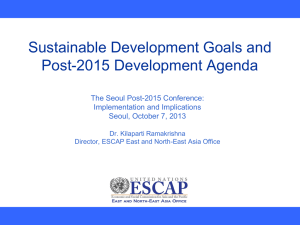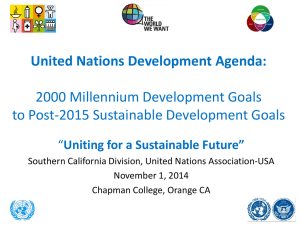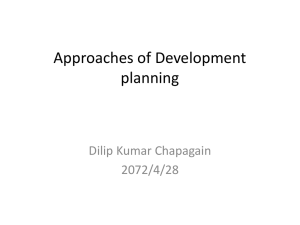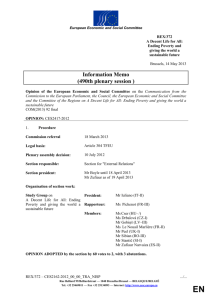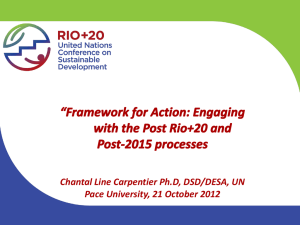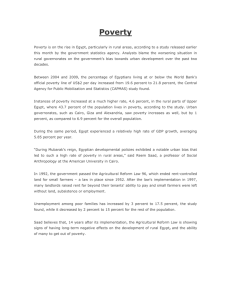Development
advertisement
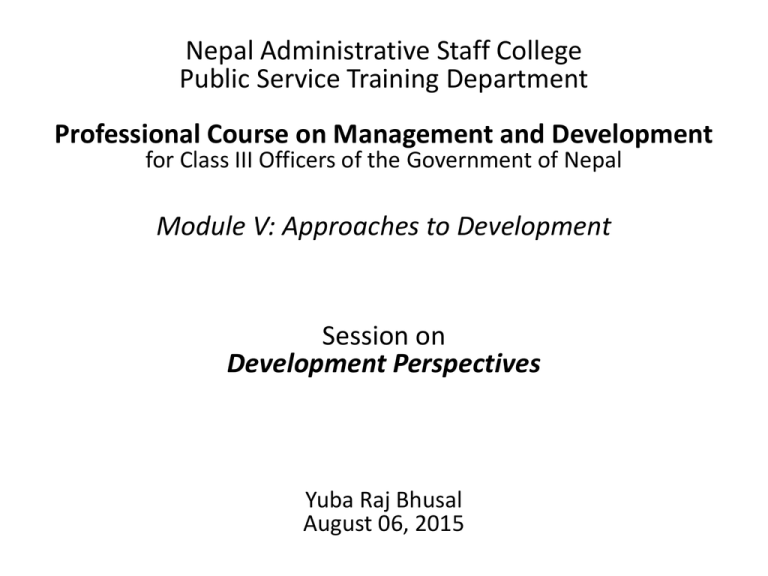
Nepal Administrative Staff College Public Service Training Department Professional Course on Management and Development for Class III Officers of the Government of Nepal Module V: Approaches to Development Session on Development Perspectives Yuba Raj Bhusal August 06, 2015 Table of Contents 1. The Concept 2. Societal Growth and General Theories of Development 3. Problems of Underdevelopment 4. Need and Practices of Planned Development 5. Rio+20 (2012) and 4 Pillars of SD 6. Recent Trends in Development with reference to Nepal 1. The Concept a) Development: Almost every writer (economist, educationist, political defines ‘development’ differently depending upon one’s own orientation. Generally, ‘development’ can be defined: scientist, bureaucrat etc.) • as a state or condition-static; • as a process/course of change- dynamic; It is a multi-dimensional process involving reorganization and reorientation of entire socioeconomic system. As a process, it improves the quality of all human lives with three equally important aspects as under. • • • Raising peoples’standard of living through enhanced income, consumption, medical services, education; Creating conditions conducive to the growth of peoples’ self-esteem through the establishment of social, political and economic systems and institutions which promote human dignity and respect; and Increasing peoples’freedom to choose by enlarging the range of their choice variables, e.g. varieties of goods and services. Development thinking often derives from the specific long- term practices, self-reflection, action inquiry, and dialogue as well as living in the company of others. b) Perspective: • It is a particular way of thinking about something especially one that is influenced by one’s own beliefs or experience. • People may use several perspectives throughout the day, they tend to prefer to respond spontaneously with the most complex meaning-making system, perspective, or mental model. The preferred perspective is called a person’s center of gravity. • Perspective helps to judge it’s real importance by considering it in relation to everything else. c) Development perspective: It explores three big questions – Is nature or nurture more important in the developmental process? That is, is our development shaped more by our genetics or our environment? – Do we develop in stages or continually? – How do we change throughout our lifespan? What elements remain stable? In the 21st century developmental thinking responds to a need for rapid change and solve problems from a more developmentallyinformed perspective. d) Interpretations of Development • Development as Economic Growth- too often commodity output as opposed to people is emphasized-measures of growth in GNP. • Development as Modernization- emphasizes process of social change which is required to produce economic advancement; • Development as Westernization- examines changes in social, psychological and political processes; • Development as Distributive Justiceview development as improving basic needs particularly for the target groups include small farmers, landless, urban under-employed and unemployed people. e) Neo-colonial Dependence: – Existence of underdevelopment due to historical evolution of an unequal international capitalist system of rich country-poor country relations; – Sets up center (developed countries) versus periphery (developing countries) contrast; – Attempts to become self-reliant and progressive are suppressed by this relationship; – Elites (e.g landlords, entrepreneurs, merchants) in the developing world enjoy high incomes, social status and political power and thus perpetuate inequality and conformity and are rewarded; – Elites serve international power groups such as multi-national firms, assistance agencies (World Bank) and other agents. 2. Societal growth and General Theories of Development Source: http://en.wikibooks.org/wiki/Economic_History#mediaviewer/File:Societal_development.png 2.1 Industrial growth and K. Marx/F. Engel's proposition 1848; 2.2 Rise of Soviet Union 1917 and the Socialist Planning System 1928; 2.3 Great Depression of 1930s and the 'New Deal' and Keynesian Economics: • New Deal: Among others some initiatives were: creation of the Works Progress Administration (WPA) to provide jobs to unemployed people; focus on building post offices, bridges, schools, highways and parks; works to artists, writers, theater directors and musicians; signing in the Social Security Act, 1935 guarantying pensions to millions of Americans; setting up a system of unemployment insurance and that the federal government would help care for dependent children and the disabled. • Keynes (1936) viewed that the process of capital formation is determined by savings and investment; – Domestic savings are channeled to productive investments such as manufacturing which result –usually-in high productivity; – Growth is market driven as income levels rise, savings rises and frees capital for alternative investment; – A government could stimulate a great deal of new production with a modest outlay.; – The people who receive the money, spend most on consumption goods and save the rest. – The extra spending allows businesses to hire more people and pay them, which in turn allows a further increase in consumer spending. Keynesian theory explains the determinants of saving, consumption, investment and production. The interaction of aggregate demand and aggregate supply determines the level of output and employment in the economy. (John M. Keynes: The General Theory of Employment, Interest and Money, 1936). 2.4 Welfare Economics (Post-war period): Role of the state redefined, from 'Police State' to 'Welfare State'. 2.5 W.W. Rostow’s Economic Growth model (1960): • Rostow asserts that countries go through each of these stages fairly linearly, and set out a number of conditions that were likely to occur in investment, consumption and social trends at each state. • The stages of economic growth constituted five milestones: traditional society; pre-take off; the take off; the drive to maturity; and maturity. 2.6 Modernization Theory (1950s-60s) – – Suggests economic dimension alone is insufficient and adds theories on institutional and social change; – Incorporates non-economic elements such as social practices, beliefs, values and customs; – Diffusion and speed of change is critical as is removal of various cultural and social barriers; – Backward internal structures-rather than external factors-cause underdevelopment. 2.7 Neo-liberal Development Theory (1970s): – Designed to counteract impact of Keynesian theory; – New emphasis on supply side factors in development- private initiatives and market led growth; – Move away from demand stimulation (interest rate manipulation), import substitution, state intervention and centralized planning; – Gradual industrialization with ‘trickle down’ of benefits to all social classes; 2.8 Popular Development (1980s): – Avoids grand theories and emphasizes solutions viewed in context of development which is part of historical process; – Context of development is constantly changing in scale and time; – Accommodates geographical and historical diversity; – Theory of little use to practitioners of development; – Stresses local diversity, human creativity, process of social change through pragmatism, flexibility and context; – Not extent of state intervention but comparative advantages of public and private sectors and their complementarities. 2.9 The World Bank Model: –WB has adopted several new policies and programs geared to promoting a more holistic, participatory, and results-based approach to development and poverty reduction. –This approach incorporates the notion that development must be • inclusive, • comprehensive, and • country-owned in order to be effective and sustainable over the long term. 3. Problems of Underdevelopment 3.1 Characteristics of underdevelopment: – low per capita incomes, – low literacy and educational attainment, – lack of basic services- water and power, – Other characteristics: political instability, conflict etc. • Absence of development caused by certain physical environments, particular cultural traditions and value systems-environmental and cultural determinism; • Lack of natural resources certainly impediment to development but not impossible- example of Japan. 3.2 Reasons for Japanese Success: • Strong cooperation between government and business; • Able to adapt to spatial-physical situation and acquire a maritime prowess; • Early development during the Meiji restoration with renovation, revolution, reform/ renewal that restored under Emperor Meiji (1868-1912); • The restoration facilitated for the emergence of Japan as a modernized nation in the early twentieth century, with the provision of transport and banking systems; • Highly literate population; • Niche development- technology driven. 3.3 Other Common Explanations of Underdevelopment • Instability and other adverse internal situationspolitical factors; • Some truth to this as extended periods of turbulence are not conducive to developmentcentral African nations with tribal rivalries and ethnic cleansing; • Poor physical environment- lack of rainfall, poor soils also may pose barriers to development; • Prevalence of extractive institutions and lack of inclusive institutions both in political and economic sectors. 3.4 Vicious Circles- Gunnar Myrdal • Complex web of interlocking vicious circles each of which constitutes a chain of cause and effect relationships where one unfavorable circumstance leads to another and produces downward spiral; • High Birth Rate> Large Families>Low PCI> Poverty> Low Output Per Worker>; • Low PCI> Low Productivity> Poor Health>Inadequate Housing; • Remedy > Downward spiral not reversible without massive aid. 3.5 Remedy for Vicious Circle • Aid would stimulate growth in modern sector and reduce size of ‘informal’ or traditional sector; • Eliminate dualism and the major causes of unequal distribution of wealth; • Foreign aid would allow countries to increase low levels of productivity; • Needs to develop a Virtuous Circle of Prosperity against the Vicious Circle of Poverty. 4. Need and Practices of Planned Development 4.1 Growth Pole approach (F. Perroux 1955) • Development of a core region or growth pole. • Leading to spread effects benefiting the country as a whole. • Development of a specific location through agglomeration (Special Economic Zones, Economic Processing Zones). • Economies of scale of the largest urban centers would provide higher rates of return on investment, support the commercial services needed by the industries to operate efficiently and bring about the diversification of the growth pole’s economy. • Spread and backwash effects (complementarities of agricultural production and manufacturing through backward and forward linkages-hinterland/urban centers). 4.2 Trickle down approach: • Richer individuals and larger companies are the thriving force behind economic growth. • The wealth created by the more successful parts of the economy and more successful people will naturally tricle down and benefit everyone. • Low taxation and lack of regulation is expected. 4.3 Decentralization: • Bottom up or grass roots development. • Local involvement in the DM process, where local people identify their needs for effective solution. • Use apt technology. • Long term aim is sustainability. 4.4 Regional Development/ Balanced Development: • focus on developing the peripheral regions. • Reduce regional disparities which develop from an uneven development of the core periphery. • Attempts to reduce rural to urban migration. • Investments in infrastructures-transportation, communication and electricity to link the region more with the core. 4.5 Agro-politan Development (J. Friedman 1975) • Any larger urban centers in rural area tend to exploit the rural people. The urban elites, traders, local industries, and the investment in the urban centers will drain resources away from the rural population. • To overcome this process, investment should be concentrated in the rural areas where the masses have access to facilities and services. • Three essential conditions for successful agropolitan development: selective territorial closure, the communalization of productive wealth, the equalization of access to the bases for the accumulation of social power against the dominance of elites’ power. 4.6 Self-reliant territorial development(SRTD): J. Friedman, 1979 devised five principles of SRTD: – aims to diversify the territorial economy; – maximum development of physical resources consistent with principles of conservation; – encourage the expansion of regional and interregional markets; – base as much as possible on principles of selfreliance; and – promote social learning. 4.7 IRDP 1970s • Poverty alleviation and meeting basic needs of the rural people become the core objective of IRDP. • Economic growth (increased agricultural and off farm production, increased productivity, higher rural incomes, improved infrastructures and technological modernization in the countryside) and poverty alleviation (transfer of assets to and creation of jobs for the poor and the satisfaction of their basic minimum needs) were the two major thrusts of IRDP. Its elements are: • multi-sectoral nature of projects; • limitation of the area of intervention (area planning, district planning); • emphasis on local participation and mobilization; and • explicit reference to poverty alleviation and to the basic minimum needs of the poor. 4.8 Basic Needs Approach (ILO 1972) • Shifting from growth oriented development strategy the basic needs approach was proposed as a new focal point for development. • ILO (1977) defines it as under: – minimum requirements of a family for consumption are adequate food, shelter and clothing including household equipment and furniture. – Essential services provided by for the community at large, i.e., safe drinking water, sanitation, public transport, health and education facilities. 4.9 Functional-spatial Integration (D. Rondinelli, 1983) • It is about the integrated spatial development. • Development encompasses rural and urban areas. • Without an articulated and integrated system of growth centers- as opposed to one or few growth poles- the impulses of concentrated investment couldn’t spread and the economic incentives for widespread productivity could not be created. • A decentralized concentration is needed. • A crucial element in providing the basic preconditions for the commercialization of agriculture is a well articulated and integrated system of settlements in which services and facilities can be efficiently located and to which rural people have easy access. 4.10 WID, WAD, GAD (1980s): Women in Development, Women & Development, Gender & Development. 4.11 Right to Development (RTD) 1970s/80s: • Advocated since 1972 (Int'l Institute of HR); • Popularly known as the third generation human rights (first generation: civil and political rights; second generation: economic, social and cultural rights); • Consists: solidarity rights, and issues of global concerns (development, environment, humanitarian assistance, peace, communication, and common heritage); • Development policies to meet the human centered and participatory elements of the definition contained in the Declaration; • Fair distribution of benefits of development and nondiscrimination in development; • Empowerment of civil society. Three Dimensions of RTD: • Political: contending perspectives and interests seeking to influence the formulation of the general principles at the HR Commissions; • Economic: focusing on equity and poverty reduction in the policies and practices in the financing of development; • Social: willingness of several development agencies to integrate in HR concepts with respects to RTD. In essence, food, education, health and voice of the vulnerable groups including the women. 4.12 Sustainable Development Development is likely to achieve lasting satisfaction of human needs and improvement of the quality of human life. More specifically, SD is the development that fulfills the needs of the present without limiting the potential for meeting the needs of future generations (the World Commission on Environment and Development, 1987). SD: Helps for the very poorest who are left with no option but to destroy their environment to survive; Floats idea of self-reliant development with natural resource constraints; Provides cost effective development using different economic criteria to the traditional –i.e. development should not degrade environment; Brings important issues forward such as of health control, appropriate technologies, food self-reliance, clean water and shelter for all; Relies on people centered activities - human beings are the resources in the concept. UNDP (HDR, 1992) devised some minimum requirements for Sustainable Development: – – – – – – Elimination of poverty; Reduction in population growth; Equitable distribution of resources; Healthier, better educated and trained people; Decentralized and more participatory government; Equitable and liberal trading system within/ among the countries; – Increased production for local consumption; – Better understanding of diversity of eco-systems, locally adapted solutions to environmental problems and better monitoring of the environmental impact of development activities. • RIO + 20 and 3 Pillars (social, economic, environmental+ institutional) of sustainable Development. 4.13 Inclusive development 2010s • Building capacity within organizations and institutions to offer persons with disabilities better access to their services. • And hence to better health, education and employment possibilities. – Geographical – Social – Other 5. Rio+20 (2012) and 4 Pillars of SD: 5.1 The Rio+20 Outcome Document emphasized in the three pillars of SD- social, economic and environmental- and added the fourth one institutional, which addresses key institutional policy and capacity issues. It highlighted in the practice and meanings associated with the production, use and management of resources eventually leading to reduce poverty; the relationship between humans and their natural, social and built environments such as air, water, food, shelter & the type of energy. The fourth pillar 'Institutional' focuses on the capacity building and thus calls for: • strengthening technical and scientific cooperation, including North-South, SouthSouth and triangular cooperation; • developing human resources including training, exchange of experiences and expertise, knowledge transfer and technical assistance, which involves strengthening institutional capacity, including planning, management and monitoring capacities. • implementing the Bali Strategic Plan for Technology Support and Capacity-building, adopted by the UNEP. • participation and representation of wo/men scientists and researchers from developing/developed countries in processes related to global environmental and sustainable development assessment and monitoring, with the purpose of enhancing national capabilities and the quality of research for policy- and decision-making processes. • inviting all the UN Agencies and other relevant international organizations to support developing countries and, in particular, the least developed countries in capacity-building for developing resource-efficient and inclusive economies, including through: – sharing sustainable practices in various economic sectors; – enhancing knowledge and capacity to integrate disaster risk reduction and resilience into development plans; – supporting North-South, South-South & triangular cooperation for the transition to a resource-efficient economy; and – promoting public-private partnerships. 5.2 Sustainable Development Goals Rio+20 Conference built a consensus to launch a process to develop a set of SDGs, based upon the MDGs and converge with the Post-2015 development agenda. It was also decided to establish an "inclusive and transparent intergovernmental process open to all stakeholders, with a view to developing global SDGs. In the Rio+20 outcome document, member States agreed that sustainable development goals (SDGs) must: a) be based on Agenda 21 and the Johannesburg Plan of Implementation. b) fully respect all the Rio Principles. c) be consistent with international law. d) build upon commitments already made. e) contribute to the full implementation of the outcomes of all major summits in the economic, social and environmental fields. f) focus on priority areas for the achievement of sustainable development, being guided by the outcome document. g) address and incorporate in a balanced way all three dimensions of sustainable development and their inter-linkages. h) be coherent with and integrated into the United Nations development agenda beyond 2015. i) not divert focus or effort from the achievement of the Millennium Development Goals. j) include active involvement of all relevant stakeholders, as appropriate, in the process. The outcome document mandated the creation of an intergovernmental Open Working Group, that will submit a report to the 68th Session of the UNGA containing a proposal for SDGs for consideration and appropriate action. Debates, discussions were held at the local, national, sub-regional, & regional level to come up with a concrete Post-2015 Development Agenda / the SDGs. The proposed sustainable development goals are: 1. End poverty in all its forms everywhere; 2. End hunger, achieve food security and improved nutrition, and promote sustainable agriculture; 3. Ensure healthy lives and promote well-being for all at all ages; 4. Ensure inclusive and equitable quality education and promote life-long learning opportunities for all; 5. Achieve gender equality and empower all women & girls 6. Ensure availability and sustainable management of water and sanitation for all; 7. Ensure access to affordable, reliable, sustainable, and modern energy for all; 8. Promote sustained, inclusive and sustainable economic growth, full and productive employment and decent work for all; 9. Build resilient infrastructure, promote inclusive and sustainable industrialization and foster innovation; 10. Reduce inequality within and among countries; 11. Make cities and human settlements inclusive, safe, resilient and sustainable; 12. Ensure sustainable consumption and production patterns; 13. Take urgent action to combat climate change and its impacts; 14. Conserve and sustainably use the oceans, seas and marine resources for sustainable development; 15. Protect, restore and promote sustainable use of terrestrial ecosystems, sustainably manage forests, combat desertification, and halt and reverse land degradation and halt biodiversity loss; 16. Promote peaceful and inclusive societies for sustainable development, provide access to justice for all and build effective, accountable and inclusive institutions at all levels; 17. Strengthen the means of implementation and revitalize the global partnership for sustainable development. 6. Recent Trends in Development with reference to Nepal • Post-2015/MDGs/SDGs 2015-30; • LDC Graduation 2020/2032 and Nepal's Graduation from LDC to DC 2022; • Access to Energy: SE4All by 2030; • Open Defecation Free (ODF) world 2030; • Poverty eradication by 2030; • Conflict/ peace sensitive development; • Issues of climate change, REDD+ etc.; • Post-disaster Rehabilitation and Reconstruction; • Federalization for accelerated development; and • New Constitution as panacea for overall development; THANK YOU
